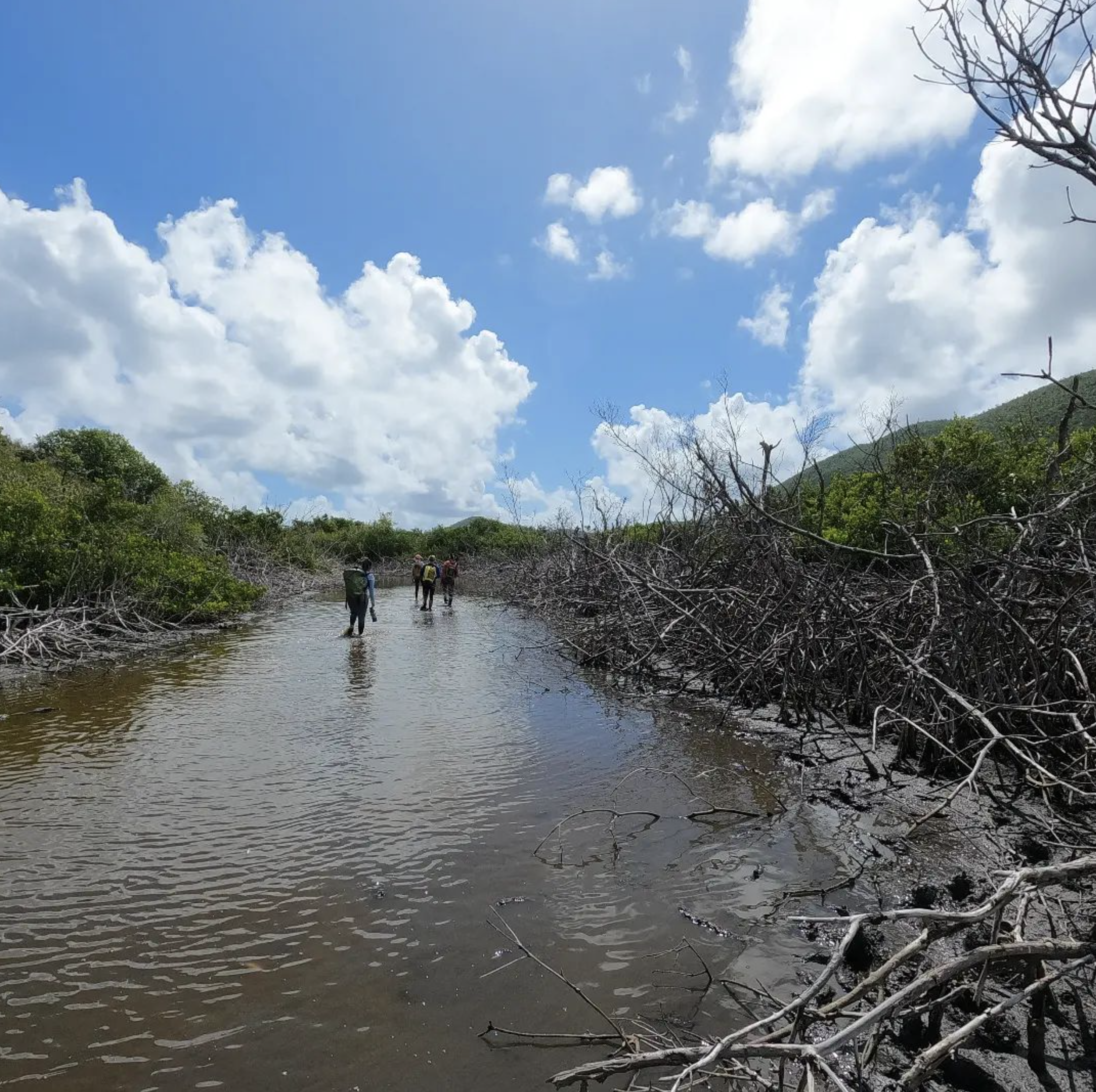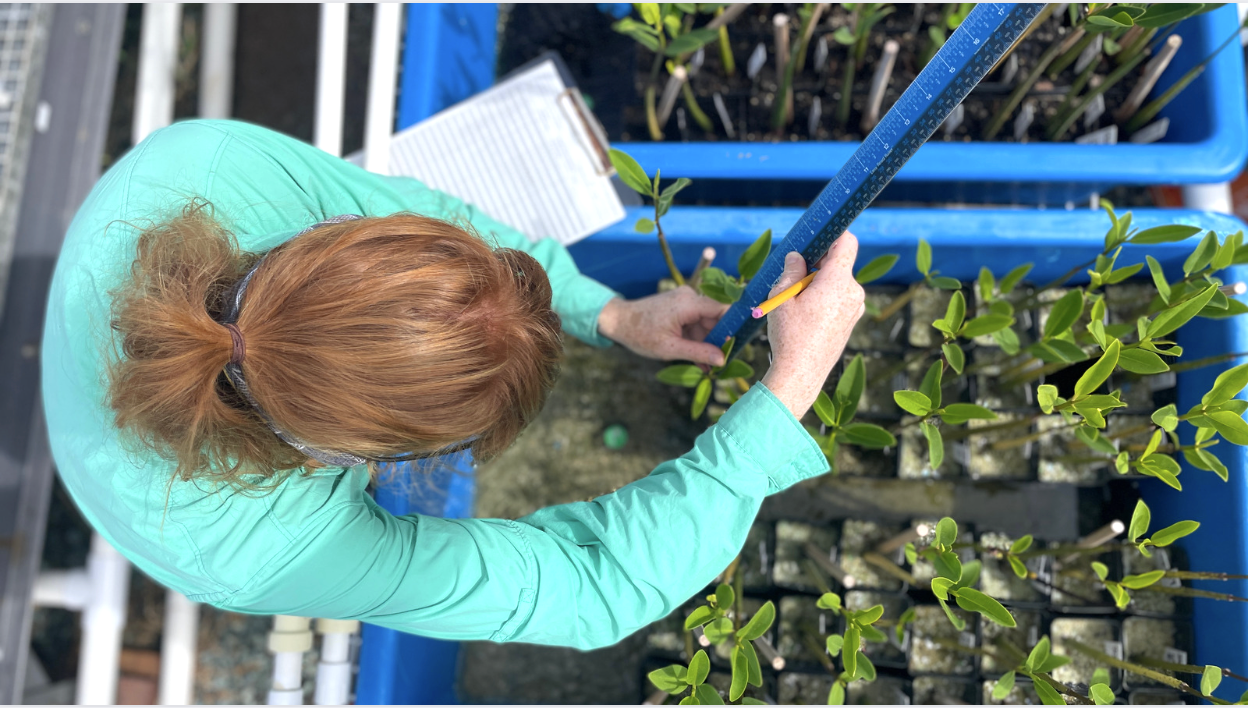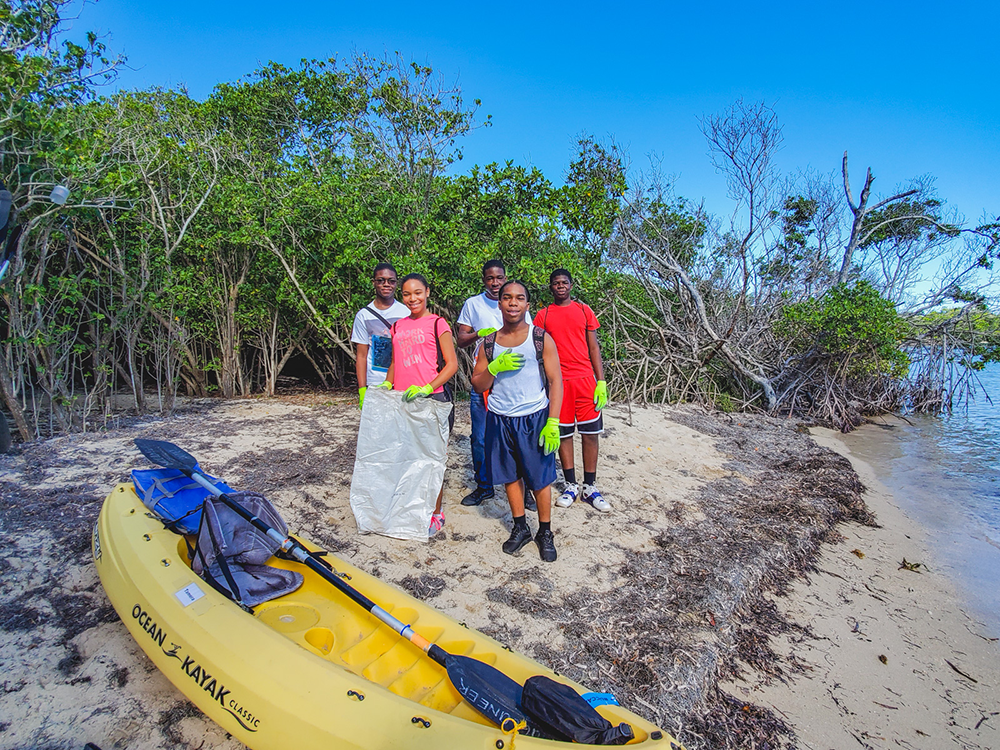Mangrove Ecosystem
Function & Recovery
Located at the edge of the land and the sea along low-energy, protected shorelines, mangrove forests provide vital benefits to people around the world and, in the U.S. Virgin Islands. Yet, large areas of mangrove forest have been lost. Those remaining are under considerable stress from both global (e.g., sea level rise, hurricanes, climatic extremes) and local (e.g., coastal development, pollution, hydrological changes) stressors. Our work in this area documents mangrove extent and condition over time, identifies areas in need of restoration, grows plants for restoration, and engages students and the USVI community in mangrove conservation, stewardship, and restoration.
Section Styles border
Mangroves in the
U.S. Virgin Islands
Hydrological alterations, coastal development, mangrove removal, drought, and hurricanes, have severely damaged U.S. Virgin Islands mangrove habitats. The 2017 Hurricanes, Irma and Maria, shrunk this habitat even more. Since then, natural forest regeneration has been slow, with some sites showing zero improvement.
Mary's Creek, St. John, USVI. Photo: A Durdall.
Undersized and collapsed culverts from road construction, alter natural hydrology that is critical for healthy mangroves. Photo: D. Mele
Mangroves Recovery
Preliminary analyses show differences in recovery by mangrove typology (salt pond, fringe or basin forest), island, and species. Compared to St. Croix sites, St. Thomas and St. John mangrove forest plots had more structural damage with greater amounts of coarse and fine woody debris. Preliminary results also indicate that forests may be recovering differently. Fringe and basin sites had higher living canopy cover, compared to salt pond sites and mangrove sites on St. Croix tended to have greater living canopy cover compared to sites on St. Thomas and St. John. A comparison of repeat measurements of St. John sites since 2018, suggest those sites are recovering, as living canopy cover has increased, with the greatest increases observed at salt pond sites. Preliminary analyses of regeneration showed differences by island, habitat type, and species, as well. Most regeneration observed was Laguncularia racemosa and St. Thomas had almost twice as many more propagules and seedlings than St. Croix or St. John, for this species. Plots had minimal regeneration of Avicennia germinans; this likely reflects the low abundance of this species, territory-wide. Rhizophora mangle regeneration was low, though propagules were recorded across all three islands in both Year 2 and Year 3; saplings were in lowest abundance on St. John. Basin sites appear to have much lower natural regeneration, of any kind, compared to fringe and salt pond sites.
Now an alumna, MMES student, Allison Holevoet, measured red mangrove (Rhizophora mangle) seedlings as part of her Master’s thesis experiment to understand whether recycled, crushed glass can be used as a growth medium in nursery settings. Her research showed that glass-grown plants had nearly the same survivorship as plants grown in potting soil, but grew more slowly and not as big. These trade-offs inform restoration practices for small, island-based nurseries, like UVI’s.
Growing plants for restoration
With the help of a dedicated team of graduate, undergraduate, high school, and middle school hands, the Grimes Lab continues to build on the 3000+ inventory of red, white, and black mangroves growing at the Orville E. Kean Campus, land-based nursery. Some seedlings are incorporated into experiments; others are merely a part of a general plant stock that will one day take root in forests in need of restoration across the territory.

“Mangroves are amazing! This project supplies new information about the condition of the territory’s mangroves since the 2017 hurricanes, provides training opportunities for students, and expands mangrove restoration efforts through community engagement and educational programs in partnership with local partners, that our team is leading. We are so excited by this work!”
— Dr. Kristin Wilson Grimes
Outreach Highlights
We are engaging students and the USVI Community
U.S. Virgin Islands youth plant mangroves with MMES student, Jordan Silva, at the Virgin Islands Children’s Museum Ecodiscovery Fair. Photo: Kristin Grimes
MMES student, Laura Palomino Bloem, plants white mangroves with Charlotte Amalie High School students, as part of the Mangroves in the Classroom project. Photo: Kristin Grimes
Mangroves in the Classroom
A new project, “Mangroves in the Classroom,” funded in part by the Schmidt Ocean Coalition, brings researchers and UVI graduate and undergraduate students into classrooms at Charlotte Amalie High School and Ivanna Eudora Kean High School and deepens relationships with local partners, including local businesses (Virgin Islands Ecotours, The Hideaway at Hull Bay), non-profits (My Brothers Workshop, Virgin Islands Conservation Society), government agencies (Virgin Islands Department of Education, DPNR, Division of Coastal Zone Management) and others, like the Virgin Islands Marine Advisory Service and VI-EPSCoR. The project developed a new USVI-specific mangrove curriculum that has students grow and experiment with mangroves in the classroom, visit local mangrove forests and the mangrove nursery at UVI, and outplant mangroves for restoration.
MMES graduate student Laura Palomino Bloem says about the experience, “The Mangroves in the Classroom project has allowed me to combine my two passions - marine conservation and education. Through this project I’ve had the opportunity to create a mangrove curriculum alongside a local high school teacher and be in the classroom working with students. Working with the teacher and students has allowed me to develop new skills that will one day help me become an education and outreach coordinator.”
MMES student, Kayla Halliday, works with Charlotte Amalie High School students to outplant red mangroves at Hull Bay, as part of the Mangroves in the Classroom project.
Learn more about the Mangroves in the Classroom Project by watching the short video below. With additional resources, the Grimes Lab hopes to expand this program territory-wide.
Mangroves In The Classroom
Section Styles top-border
Additional Resources
Follow the work of the Grimes Lab on Instagram at GRROE USVI Mangroves and its partner program, the USVI Storm Strong Program. Plus, learn more about the NSF INCLUDES SEAS Islands Alliance (coming soon).
Marine Debris
The Grimes Lab also works on marine debris prevention, removal, and research efforts in the territory, especially as it effects mangrove ecosystems. Read on to learn more.
Volunteers help to remove marine debris from mangrove coastlines at the St. Croix Great Mangrove Cleanup in Salt River. File photo.
Marine debris is a pervasive problem globally, and one felt local in the USVI. File photo.
In The USVI, Approximately 90% Of Marine Debris Comes From Land-Based Sources
The community, government entities and private organizations have been hosting and participating in marine debris cleanups and awareness campaigns since the 1980’s. “The Tide Is Turning On Marine Debris In The Territory” provides an in-depth discussion of the problem and the actions taken to address it. This timeline also summarizes cleanup and other marine debris related efforts over the years.
The first annual Great Mangrove Cleanup took place in 2018 in the St. Thomas East End Reserve (STEER; Permit No. DFWCZM 17004T funded in part by the National Oceanic & Atmospheric Administration (NOAA) Coral Reef Conservation Program and the NOAA Marine Debris Program). Since then, cleanups have taken place across St. Thomas each year and expanded to include St. Croix and St. John. These cleanups provide a unique opportunity to compare marine debris data across different coastal habitats. Our infographics summarize the data collected over the years and across locations.
The USVI Marine Debris Curriculum & Loaner Kit Program
Prevention and awareness are key to solving the marine debris problem. That is why we have worked in partnership with NOAA under the Marine Debris Program Prevention grant entitled“Pride in Our Seas, Pride in Ourselves: Preventing Land-Based Sources of Marine Debris in the US Virgin Islands through educational Transformation and Community Engagement”to create a Marine Debris Curriculum for the US Virgin Islands. This curriculum was co-created with input from USVI educators who participated in NOAA- and VI EPSCoR- funded Marine Debris Educators Workshops. Additional input was gathered following in-class use and from teachers who participated in VI-EPSCoR’s Summer STEM Institutes for Teachers. These workshops were led by the Virgin Islands Institute for STEM Education Research & Practice (VI ISERP).
We hope this curricula will be used and shared broadly to inspire coastal stewards of all ages to do their part in preventing marine debris and to care for the coasts we treasure here in the USVI. To download, print or share a copy of the Marine Debris Curriculum click on the link below.
Learn more about the Loaner Kit Program or loan a kit for free. Contact Zola Roper on St. Thomas/St. John or Kai Neilson on St. Croix
The USVI Marine Debris Action Plan
The USVI Marine Debris Action Plan is a living document created to protect the USVI coasts, people, and wildlife from the impacts of marine debris. The plan is a result of input and feedback from stakeholders at workshops held in 2020 and 2021.
Marine Debris Resources
To learn more, check out the USVI marine debris resources our team have created.

Kristin Wilson Grimes, Ph.D. she/her/hers
Project Lead
I am a Research Associate Professor in the Center for Marine & Environmental Studies at the University of the Virgin Islands (UVI). My research examines human impacts to nearshore environments, especially mangroves.
At UVI, I teach in the Masters of Marine & Environmental Science program, mentor students, and engage the community through outreach and education, running the Mangroves in the Classroom project and the territory-wide Great Mangrove Cleanups.
I am also the Director for the Virgin Islands Water Resources Research Institute, a network of 54 institutes across the US in partnership with the U.S. Geological Survey.
Section Styles background
Meet The Team
ADDITIONAL TEAM MEMBERS – CURRENT AND PAST
GRROE USVI Mangroves Program Manager
Allie Durdall
Workforce Fellows
Zoe Banfield
Amanda Boissiere
Jahnyah Brooks
Taylor Brunson
Chloé Camacho
Nicholas DurgadeenRebecca Gibbel
Miranda Goad
Delsabriana González
Sam Gittens, Jr.
Erin Hollander
Allison HolevoetSierrah Mueller
Kaitlin Rommelfanger
Zola Roper
Larissa Sweeney
Joseph Townsend
Other Professional Partners
Kwami Alexander
Genae Gonzalez
Zola RoperHeather Steward
Avia (Huisman) Tarnawaska
Graduate Students
Kayla Halliday
Jordan Silva
Ella Troutman
Sarai HutchinsonLaura Palomino Bloem
Lila Uzzell
Julia Plotkin
Past Graduate Students
Allison Holevoet
Zola Roper
Kelsey Vaughn
Past Undergraduate Students
Amanda Boissiere
Zachary Briggs
Heather Bruck
Owen Clower
Nicholas Durgadeen
Allie Durdall
Miranda GoadDenny Gonzalez
Stephanie Hibberts
Amelie Jensen
Ian Jin
Jessica Keller
Molly Mason
Sydney NickKaidrian Ottley
Maggie Rios
Kaleigh Schlender
Ellie Tanko
Tara Thompson
Aaliya Warner-Rawlins
High School Students
Elyse Ayala
Flame Gonzalez
D’Jani Hurtault
TJ Roy
Kanesha Tonge
In Memoriam
Stephanie Hibberts
Stephanie started in the lab in 2019 after graduating with a B.S. in Geology from Clemson University. Her work focused on assessing the condition of mangroves since the 2017 storms and creation of an index that will assist in mangrove restoration efforts. Stephanie unexpectedly passed away in July 2021. Her tragic loss has been deeply felt by all within the Grimes Lab.
Kwami Alexander joined the Grimes Lab in February as a Securing STEM Islands Pathways, Short-Term Workforce Fellow. This eight-week position was funded by a new NSF RII-BEC grant awarded to Dr. Grimes and Dr. Lawanda Cummings. Kwami was a 2022 graduate of UVI’s Biology Program and assisted with fieldwork, mangrove education and outreach in local schools, and stakeholder workshop planning, along with daily tasks at the mangrove nursery. Tragically, Kwami passed away in July 2023. His loss is felt deeply.
Kwami Alexander





















